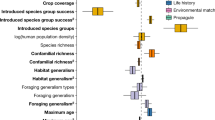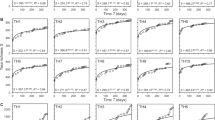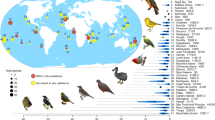Abstract
The question of what causes species extinction and how to prevent it is a crucial one for both basic and applied ecology. Three kinds of island-biogeographical field studies have made particularly important contributions towards this problem. First, a variety of bird studies suggest for small populations a negative relation between extinction time and population size; smaller islands typically have smaller populations (see ref. 1 and H. L. Jones, J. M. Diamond and M. Gilpin, manuscript in preparation). Second, in a study on arthropods2, experimentally reducing the area of already saturated mangrove islands caused numbers of species to decrease, presumably because of reduced population sizes. Third, in a study of mammals3 in which small, variably sized populations of colonists (propagules) were experimentally introduced onto islands, larger propagules survived longer. In the present study with lizards, both island area and propagule size were varied experimentally in an attempt to separate their effects. The results show: (1) for a given species, time to extinction increased with island area in a monotonic fashion; (2) above a certain island area, rapid colonization occurred; below that threshold, propagules went extinct quickly; and (3) propagule size had no effect.
This is a preview of subscription content, access via your institution
Access options
Subscribe to this journal
Receive 51 print issues and online access
$199.00 per year
only $3.90 per issue
Buy this article
- Purchase on Springer Link
- Instant access to full article PDF
Prices may be subject to local taxes which are calculated during checkout
Similar content being viewed by others
References
Williamson, M. Island Populations (Oxford University Press, 1981).
Simberloff, D. Ecology 57, 629–648 (1976).
Crowell, K. L. Am. Nat. 107, 535–558 (1973).
Schoener, T. W. & Schoener, A. J. Amin. Ecol. 52(1) (1983).
Schoener, T. W. & Schoener, A. J. Anim. Ecol. 52(1) (1983).
Levins, R. & Heatwole, H. Ecology 54, 1056–1064 (1973).
Williams, E. E. Q. Rev. Biol. 44, 345–389 (1969).
Schoener, T. W. & Schoener, A. J. Anim. Ecol. 49, 19–53 (1980).
Schoener, T. W., Proc. 16th int. orn. Congr., 629–642 (1976).
Schoener, T. W. & Schoener, A. Oikos 39, 1–16 (1982).
Turner, F. B. in Biology of the Reptilia Vol. 7 (eds Gans, C. & Tinkle, D. W.) 157–264 (Academic, London, 1977).
MacArthur, R. H. & Wilson, E. O. The Theory of Island Biogeography (Princeton University Press, 1967).
Goel, N. S. & Richter-Dyn, N. Stochastic Models in Biology, Ch. 4 (Academic, New York, 1974).
Seber, G. A. F. The Estimation of Animal Abundance, 145 (Griffin, London, 1973).
Fienberg, S. E. Biometrika 59, 591–603 (1972).
Heckel, D. G. & Roughgarden, J. Ecology 60, 966–975 (1979).
Black, F. L. J. theor. Biol. 11, 207–211 (1966).
Schoener, T. W. & Schoener, A. in Festschrift for Ernest Williams (eds Rhodin, A. & Miyata, K.) (Special Publ. Museum Comparative Zoology, Harvard University, 1982).
Schoener, T. W. Theor. Pop. Biol. 4, 56–84 (1973).
Author information
Authors and Affiliations
Rights and permissions
About this article
Cite this article
Schoener, T., Schoener, A. The time to extinction of a colonizing propagule of lizards increases with island area. Nature 302, 332–334 (1983). https://doi.org/10.1038/302332a0
Received:
Accepted:
Issue Date:
DOI: https://doi.org/10.1038/302332a0
This article is cited by
-
Predator-induced collapse of niche structure and species coexistence
Nature (2019)
-
How propagule size and environmental suitability jointly determine establishment success: a test using dung beetle introductions
Biological Invasions (2016)
-
Island biogeography of the Anthropocene
Nature (2014)
-
Adaptive differentiation following experimental island colonization in Anolis lizards
Nature (1997)
-
Natural selection out on a limb
Nature (1997)
Comments
By submitting a comment you agree to abide by our Terms and Community Guidelines. If you find something abusive or that does not comply with our terms or guidelines please flag it as inappropriate.



